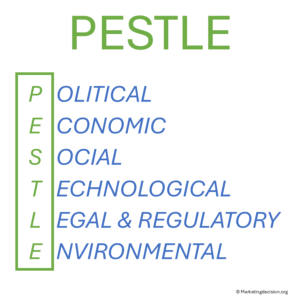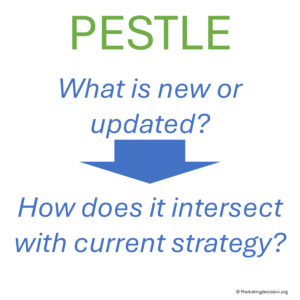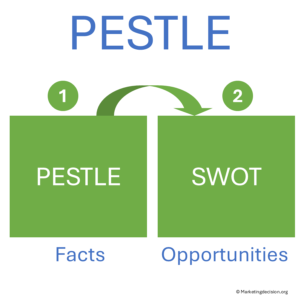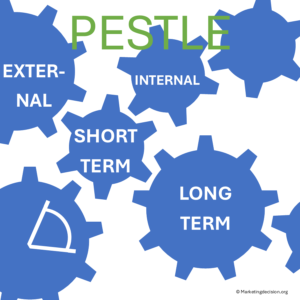
Market PESTLE Analysis—also known as PESTEL or PEST analysis—plays a vital role in enhancing market understanding, a critical aspect when designing a business plan or considering the launch of a new product. It encourages a 360° view of the market by examining six key dimensions: Political, Economic, Social, Technological, Legal, and Environmental.
These dimensions are described in more detail in this Wikipedia reference article.
In addition to them, Demographic, Regulatory, and Inter-Cultural aspects may also be considered depending on your market context.
The market is in a constant state of evolution—sometimes gradual and imperceptible, other times sudden and disruptive. Maintaining a broad perspective helps anticipate risks and opportunities before they become visible to competitors.
Leverage both external and internal knowledge to strengthen market understanding. Ensure that discussions about the market environment precede a deep dive into specific opportunities. The greater risk is to have a crucial review overly focused on a single topic, while multiple opportunities—and potential threats—remain undetected.
See also: Market Visibility: Spot Early Signals for Competitive Advantage.
A PESTLE analysis should be reviewed and revised regularly. Remember that it is not an objective in itself but rather a means to ask relevant business questions about future impacts. It helps teams identify what has changed, what is emerging, and how these factors intersect with product plans, marketing strategies, and communication priorities.

PESTLE analysis helps answer two crucial questions:
For practical questions related to each dimension, consult PESTLE Analysis Questions.
Read also: Porter’s Five Forces Analysis.
 A SWOT analysis can be a powerful complement to summarize key findings from a detailed PESTLE discussion.
A SWOT analysis can be a powerful complement to summarize key findings from a detailed PESTLE discussion.
PESTLE highlights the external environment, while SWOT consolidates insights into Strengths, Weaknesses, Opportunities, and Threats.
Integrating both tools enables structured strategic thinking and clear decision prioritization.
See also: SWOT Analysis Methods and Examples.

Regular use of PESTLE analysis proves highly beneficial. Instead of recreating an entire study, consider periodic updates to maintain awareness of changing market forces.
When engaging an external company for market research, request the inclusion of PESTLE analysis to gain an independent view of your business environment.
Additionally, when gathering your marketing and sales teams, take the opportunity to discuss current and anticipated changes. Evaluate which factors matter most and what actions should be prioritized.
PESTLE analysis serves as an excellent first step before discussions about risks, opportunities, and portfolio investments.
Incorporate your marketing team in the development of a PESTLE analysis. Ensure the use of reliable external data sources, and document references to allow comparisons over time.
The Symbol Text Generator tool (see below) simplifies visual summaries—using symbols, colors, or arrows—to make insights more concise and presentation-ready.
While the real value lies in team discussion and preparation, this tool helps consolidate ideas efficiently.
Key Features
PESTLE analysis is a recurring effort aimed at understanding the market and enabling companies to adapt and chart the best course in an ever-changing environment.
Use alternative models when necessary, but never underestimate the importance of capturing the market’s external view, considering it from the perspective of both competition and customers.
PESTLE stands for Political, Economic, Social, Technological, Legal, and Environmental factors—key external forces that influence market strategy.
It helps companies anticipate risks and opportunities, align strategy with external trends, and build resilience in fast-changing environments.
At least once or twice a year, or whenever major external shifts occur—such as new regulations, economic downturns, or technological disruptions.
PESTLE provides external context, while SWOT translates those insights into internal actions by identifying strengths, weaknesses, opportunities, and threats.
Yes. You can tailor the model to emphasize sector-relevant factors—for example, environmental and regulatory aspects for energy, or technological change for digital sectors.
© marketingdecision.org
The tool presented here—also referenced in the Porter’s Five Forces chapter—streamlines the creation of concise statements, allowing users to incorporate visual cues such as colored arrows or symbols.
This feature is particularly helpful for those who want to communicate clear, impactful messages using color coding (e.g., red for risks, green for opportunities) in their presentations.
When collecting and consolidating valuable market information, a wide range of sources is available, including official statistical reports and market research compiled by external agencies. The first challenge is to identify reliable sources; the next is to distill and report only the most meaningful and actionable insights.
Read also this section on Market Research from the Customer Mix chapter.
PESTLE analysis encourages teams to adopt an external, 360-degree perspective—viewing the market not just from the company’s standpoint but also as competitors would.
To maximize learning, organize marketing meetings where teams can share and consolidate their findings, ideally before a market opportunity review.
This collaborative approach ensures a comprehensive understanding of the market environment and supports informed strategic decisions.
The following section may include tools, some free, some with a fee to support this site development. If you consider a tool should be presented in this section and is missing, please let us know at: contact@marketingdecision.org
 The Symbol Text Generator is an Excel tool that helps synthesize key ideas into short, crisp messages with the aid of symbols. Whether summarizing findings after a workshop or preparing a presentation, conveying insights clearly is essential. Given the significant volume of data from a Porter’s Competitive Analysis or PESTLE, using symbols and colors can enhance communication and presentation.
The Symbol Text Generator is an Excel tool that helps synthesize key ideas into short, crisp messages with the aid of symbols. Whether summarizing findings after a workshop or preparing a presentation, conveying insights clearly is essential. Given the significant volume of data from a Porter’s Competitive Analysis or PESTLE, using symbols and colors can enhance communication and presentation.
Crafting precise text with meaningful symbols can be time-consuming. This tool simplifies the process by enabling users to add symbols at the beginning or end of sentences and select colors aligned with their company’s branding. In addition to pre-formatted pages for Porter’s and PESTLE analyses, it includes a free-text page for general use. Simply prepare your text with symbols, copy and paste it into your presentation—it’s that easy.
© 2025 MARKETING DECISION SOLUTIONS. All Rights Reserved.
The SWOT analysis is an approach used to summarize multiple insights gained from tools such as PESTLE, Porter’s Five Forces, and other market research methods. SWOT stands for Strengths and Weaknesses—both internally focused—and Opportunities and Threats, which are externally driven. These four elements are typically presented in four quadrants.
Strengths and Weaknesses require an assessment of a company’s internal capabilities in relation to a changing environment and may seem static, as they provide a snapshot of the company at a given time. In contrast, Opportunities and Threats prompt action and help answer the “so what?” questions that arise from understanding market opportunities and risks.
SWOT can serve as a transition tool, helping to translate market events into opportunities that teams can discuss. The Risk and Opportunity matrix is also useful for summarizing and discussing the impact and probability of such events. The subtlety of these tools lies in the fact that opportunities and risks are not always easy to identify or even to classify simply as either a risk or an opportunity. The apparent simplicity of these tools is contradicted by the effort required to use them effectively.
Finally, risks are similar to opportunities: when addressed efficiently, they may actually become advantages over the competition. On the other hand, opportunities that cannot be adequately addressed may become risks. For instance, a market that is doubling in size will likely be identified as an opportunity, but if the capability to serve this market is lacking, it can become a risk compared to competitors who are better positioned.
© 2025 MARKETING DECISION SOLUTIONS. All Rights Reserved.